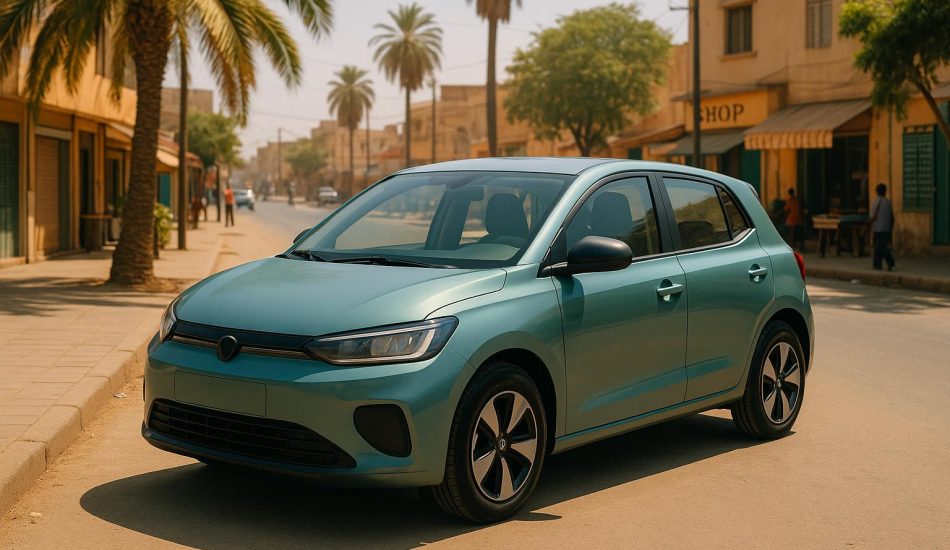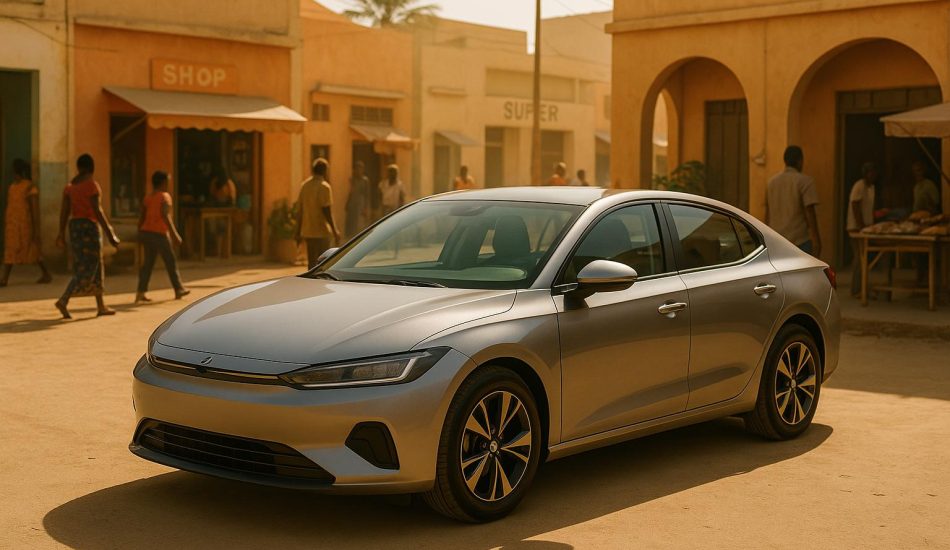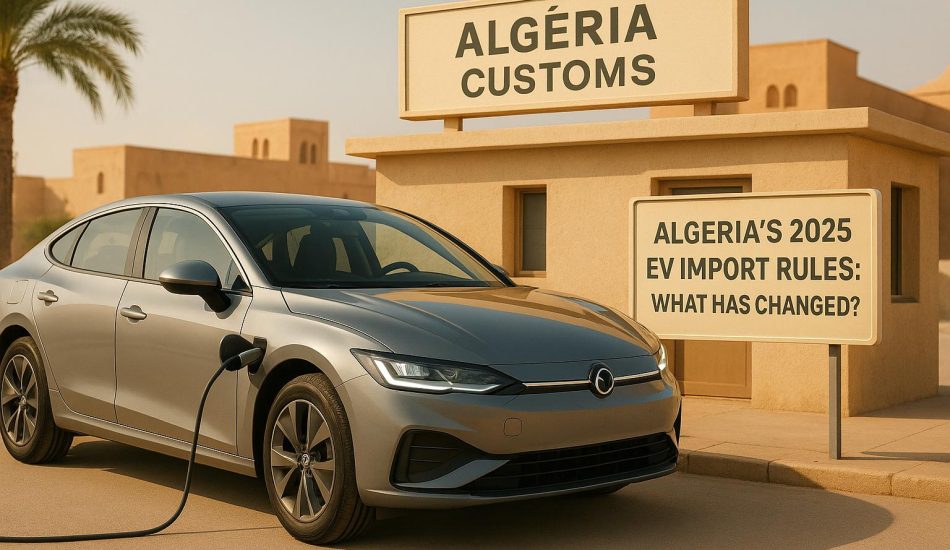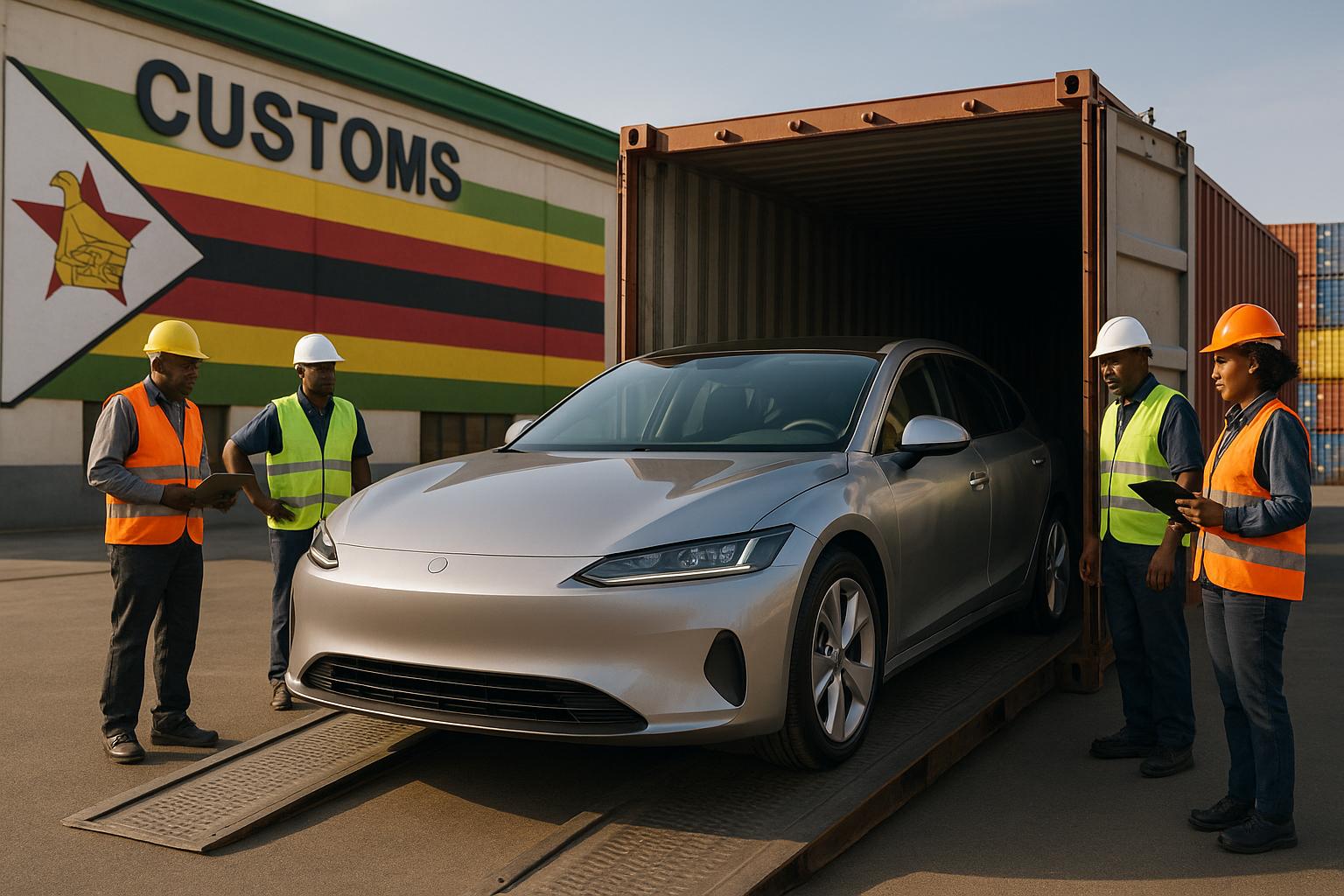
Importing an electric vehicle (EV) to Zimbabwe in 2025 is easier and more affordable than ever, thanks to reduced customs duties and government incentives. With a 25% customs duty (down from 40% for traditional vehicles), zero surtax for EVs under five years old, and growing charging infrastructure, now is the ideal time to make the switch. Here’s a quick guide to help you navigate the process:
- Research EV Models: Choose an EV that suits Zimbabwe’s roads and climate, with a range of at least 200 miles and both AC/DC charging options.
- Understand Import Regulations: EVs must be under 10 years old and meet safety standards. Gather documents like the bill of lading, import permit, and vehicle registration.
- Calculate Costs: Factor in the vehicle price, shipping, taxes, and duties. Use tools like EV24.africa‘s cost calculators for accurate estimates.
- Arrange Shipping: Options include Roll-on/Roll-off, container shipping, or groupage. Delivery typically takes 4–8 weeks.
- Clear Customs: Submit documents via ZIMRA’s ASYCUDA system, and work with an agent to ensure smooth clearance.
- Register Your EV: Complete local registration, pay fees, and secure a radio license.
- Find Support: Use platforms like EV24.africa for maintenance advice, charging solutions, and technician referrals.
Zimbabwe’s EV Market in 2025: Lower costs, a growing charging network, and eco-friendly policies are driving EV adoption. Platforms like EV24.africa simplify importing and owning an EV, offering delivery support, cost tools, and ongoing assistance.
Switching to an EV saves on fuel and maintenance while contributing to a cleaner future. Ready to start? Follow these steps to bring your EV home.
Vehicle registration & change of ownership in Zimbabwe 🇿🇼
Step 1: Research Electric Vehicles for Import
When considering an electric vehicle (EV) for import to Zimbabwe, it’s important to choose a model that can handle the country’s unique challenges, like irregular power supply and limited charging infrastructure in major cities. Look for an EV that combines durability, range, and charging flexibility while staying budget-friendly. Zimbabwe’s roads vary from smooth city streets to rugged rural paths, so your EV needs to perform well across diverse terrains. This initial research is a critical step for a hassle-free import experience.
Find EV Models That Fit the Bill
Focus on EVs with strong battery performance and reliable thermal management systems to handle Zimbabwe’s high temperatures, which can affect battery life. Models with advanced thermal management ensure consistent performance, even in the country’s fluctuating climate.
Opt for vehicles with at least a 200-mile (320 km) range to minimize concerns about limited charging stations. A great example is the GWM ORA 03, which offers a 200-mile range and costs just over $6 to fully charge – a fraction of the cost of fueling a conventional car for the same distance.
"With any traditional vehicle, how far will 6 U.S. dollars of fuel get you? Nowhere near 320 kilometers. So it is obvious that the cost of energy, or cost of electric refueling, is much cheaper, and the range is longer."
– Tafadzwa Nyabuta, Marketing Officer for ZIMOCO
Ensure the EV supports both AC and DC fast charging. For instance, the Aiways U5 comes with Type 2 AC charging (up to 11 kW, taking about 6.5 hours for a full charge) and CCS DC fast charging (up to 92 kW, charging from 10% to 80% in approximately 34 minutes).
Maintenance and parts availability are equally important. Well-established brands like Tesla, Nissan, and BYD often have better support networks and spare parts availability. As Kudakwashe Ngoni, an EV owner in Harare, noted:
"I currently drive one, and it has been a great investment."
– Kudakwashe Ngoni
Pay attention to ground clearance and build quality, as your EV will need to handle both urban roads and rougher rural conditions. Many manufacturers design models specifically for the African market, with reinforced components that suit varied terrains. Carefully selecting the right model now can help you avoid complications later.
Explore EV Options on EV24.africa
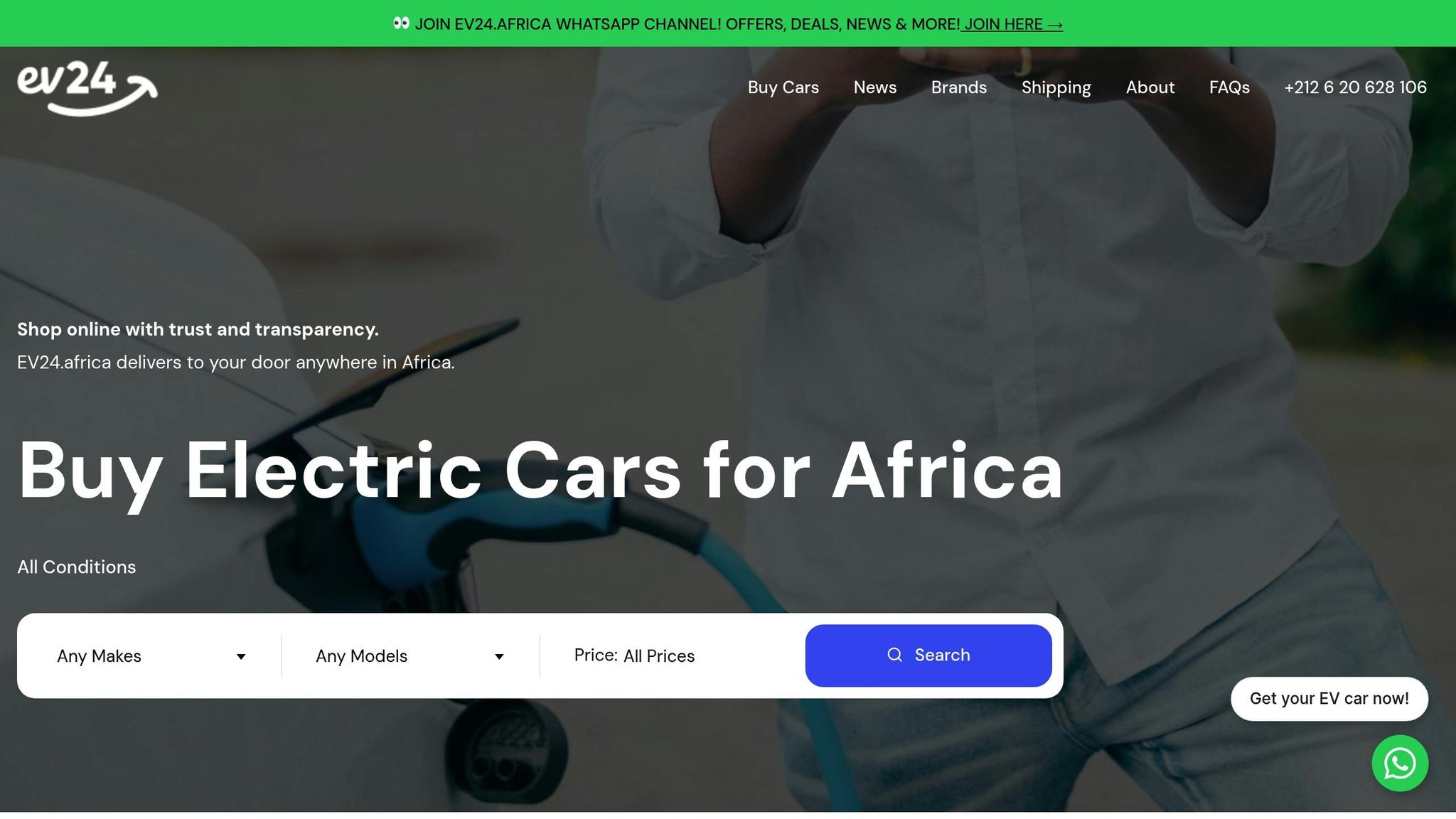
Once you’ve identified the features you need, head to EV24.africa to compare models and pricing. This platform specializes in EVs tailored for Africa, offering detailed specifications and transparent pricing. You’ll find a range of vehicles from trusted brands like Tesla, BYD, Leapmotor, Geely, Hyundai, and Toyota.
EV24.africa allows you to easily compare pricing and features side by side. For example, used Nissan Leaf models from 2018 to 2021 are priced between $7,900 and $12,750 FOB, while Tesla Model Y vehicles from 2022 to 2023 range from $20,350 to $26,150 FOB. This clarity helps you plan your budget effectively.
The platform also lets you filter models based on criteria like range, charging type, and price. You can view detailed information such as charging capabilities, warranty coverage, and real-world performance data. For personalized advice, EV24.africa’s customer support team can recommend models based on your budget, intended use, and local infrastructure.
Additionally, EV24.africa provides financing options and delivery services across all 54 African countries, simplifying the logistics of importing your EV.
Zimbabwe’s goal of reaching 33% EV market penetration by 2030 signals improvements in infrastructure. By choosing a reliable EV now, you’ll not only save on fuel and maintenance but also be well-positioned to benefit from the country’s growing EV ecosystem.
Step 2: Check Import Regulations and Requirements
Understand Zimbabwe’s EV import rules to make the process smoother and take advantage of the country’s eco-friendly initiatives.
Import Duties and Tax Rates
Zimbabwe has introduced lower import duties on electric vehicles to encourage their adoption. Finance Minister Professor Mthuli Ncube explained this change, saying:
"Cognisant of the need to promote use of eco-friendly vehicles, which will result in reduced carbon emissions, I propose to reduce Customs Duty on Electric Motor Vehicles, with effect from 1 January 2025"
Currently, electric vehicles are subject to a 25% customs duty – lower than the 40% applied to internal combustion engine (ICE) vehicles. They also incur a 15% VAT but are exempt from surtax if the vehicle is under five years old. For a $20,000 EV, this could mean savings of up to $3,000 compared to importing an ICE vehicle. With these rates in mind, ensure you have the right paperwork for a seamless customs process.
Required Documents
To ensure quick customs clearance and registration, gather the following documents before your EV arrives:
- Bill of lading confirming shipment details.
- Certificate of origin verifying where the EV was manufactured.
- Proforma invoice outlining the vehicle’s value, shipping costs, and insurance.
- Import permit issued by the Zimbabwe Revenue Authority (ZIMRA).
- Vehicle registration documents from the exporting country.
- Insurance certificates for the shipping period.
- Personal identification, such as a valid passport and proof of residence in Zimbabwe.
Having these documents in order will help you take full advantage of Zimbabwe’s EV-friendly import policies.
Vehicle Requirements
According to Statutory Instrument 54 of 2024, any imported EV must be less than 10 years old. Additionally, it must meet all relevant safety and environmental standards to be eligible for importation.
Step 3: Calculate Total Import Costs
After selecting your EV model and understanding the regulatory requirements, the next step is calculating the total import costs. This step ensures you’re prepared for all expenses involved, not just the vehicle’s price. In Zimbabwe, these costs are summed up under what’s known as the Value for Duty Purposes (VDP).
Cost Breakdown
Import costs for EVs in Zimbabwe are calculated using the CIF (Cost, Insurance, and Freight) method, which forms the foundation for determining duties and taxes. The Zimbabwe Revenue Authority (ZIMRA) calculates the VDP by combining the CIF value with additional charges incurred up to the vehicle’s first entry point into Zimbabwe, such as port handling and storage fees. The VDP, along with other incidentals, is then used to calculate the overall tax value (VTP).
Here’s a breakdown of the key cost components:
| Cost Component | Description | Typical Range |
|---|---|---|
| Vehicle Purchase Price | Base price of the EV in U.S. dollars | Varies by model |
| Shipping Costs | Ocean freight to a regional port | $3,400 – $6,700 |
| Marine Insurance | Coverage during transit | 1-2% of vehicle value |
| Port Handling & Storage | Fees at the entry point | $600 – $1,500 |
| Ground Transport | Overland transport to Zimbabwe (if needed) | Included in shipping range |
| Customs Duty | 25% of VDP for EVs | 25% of VDP |
| VAT | Applied to the VTP | 15% of VTP |
For example, ZIMRA provides scenarios such as a sedan with a CIF value of $4,000 and "Other Charges" of $1,200, resulting in a VDP of $5,200. Another example shows a vehicle with a CIF value of $5,000 and "Other Charges" of $900, bringing the VDP to $5,900.
Since Zimbabwe is landlocked, imported EVs typically arrive at a nearby port before being transported overland. Shipping costs generally include both ocean freight and the final leg of overland transit.
Important note: ZIMRA may reevaluate the declared value of a vehicle if it doesn’t align with current market prices. To avoid issues, ensure your declared value accurately reflects the market rate for your EV model.
Cost Estimation Tools
To estimate your total import costs, several online tools can provide a clear picture before you commit to a purchase. These tools take into account the specific details of your EV and apply the relevant import duties and taxes.
- EV24.africa offers calculators tailored for electric vehicle imports to African countries, factoring in reduced duty rates for EVs and Zimbabwe’s specific requirements.
- General tools like Easyship’s Import Tax & Duty Calculator and SimplyDuty’s Duty Calculator can also help with initial estimates.
When using these calculators, you’ll need details such as your EV’s Harmonized System (HS) Code, country of origin, destination, and declared value. These inputs help calculate the "landed cost", which includes the vehicle price, transportation, customs duties, taxes, insurance, and handling fees.
To get accurate estimates, collect shipping quotes, verify market values, and factor in all incidental charges. This comprehensive approach ensures you’re well-prepared financially and can confidently evaluate which EV models offer the best overall value after import costs.
Step 4: Arrange Shipping and Delivery
Once you’ve got your cost estimates sorted, it’s time to set your EV on its journey. Typically, your EV will arrive at a regional port like Durban in South Africa before being transported overland to Zimbabwe. The shipping method you choose will impact both the timeline and overall costs, so it’s crucial to weigh your options carefully.
Shipping Methods
There are three main ways to ship EVs to Zimbabwe, each with its own perks:
- Roll-on/Roll-off (Ro/Ro) Shipping:
This method involves driving your operational EV onto the ship for secure transport. Shipping from the UK to Durban via Ro/Ro costs about £1,740.00. However, some carriers, like Hoegh Autoliners and Wallenius Wilhelmsen, only accept new EVs or hybrids. If you’re importing a used EV, confirm that your shipping provider works with carriers like K-Line, which ships second-hand EVs in good condition. You’ll also need to provide your vehicle’s charge information to ensure safe handling. - Container Shipping:
If your EV isn’t operational or you want extra protection, container shipping is a solid choice. Full Container Load (FCL) shipping provides a dedicated container for your vehicle. However, keep in mind that lithium battery regulations may add to the cost due to specific documentation and handling requirements. - R-RAK Groupage Shipping:
This option allows up to four vehicles to share a standard 40-foot container, making it a more affordable choice. The cost for R-RAK groupage shipping from the UK to Durban is approximately £1,667.00.
Here’s a quick comparison of the three options:
| Shipping Method | Cost (UK to Durban) | Best For | Key Considerations |
|---|---|---|---|
| Ro/Ro | £1,740.00 | Operational EVs | Some carriers only accept new EVs |
| R-RAK Groupage | £1,667.00 | Budget-friendly option | Shares space with other vehicles |
| FCL Container | Variable | Non-operational EVs or added protection | Extra costs for battery handling |
Ro/Ro shipping is particularly convenient since it avoids the need for battery removal, saving both time and money. If you’re shipping a used EV via Ro/Ro, make sure your provider partners with carriers like K-Line and double-check your vehicle’s charge status before shipping.
EV24.africa’s Delivery Support
If you’re looking for a hassle-free experience, EV24.africa offers specialized delivery support. They simplify the shipping process with their well-established logistics network, providing both port-to-port and door-to-door delivery services.
- Port-to-Port Service: Your EV is shipped to Durban, and you handle the overland transport and customs clearance.
- Door-to-Door Service: EV24.africa manages the entire journey, from departure to delivery at your location in Zimbabwe.
Delivery times to Zimbabwe generally range from 4 to 8 weeks, depending on factors like the shipping method, departure schedules, and potential customs or overland transport delays. Ro/Ro services, with their frequent departures, can help cut down on overall transit time.
EV24.africa also assists with preparing your vehicle for shipping. They guide you through the documentation process, ensure compliance with battery charge requirements, and help you meet regulations for both departure and destination countries. Their comprehensive support can save you from common delays and make the entire process smoother.
For first-time importers, having this kind of expert assistance can make all the difference in ensuring your EV arrives safely and on time in Zimbabwe.
sbb-itb-99e19e3
Step 5: Handle Customs Clearance
When your EV arrives at the port, your next priority is navigating the customs clearance process with the Zimbabwe Revenue Authority (ZIMRA). This step is crucial to ensure your vehicle passes all necessary inspections and is cleared for registration.
Customs Paperwork
At this stage, you’ll need to finalize your document submission using the ASYCUDA World system, an online platform ZIMRA uses to handle customs clearance. Accurate and complete documentation is essential to avoid delays or penalties.
The Tax Clearance Certificate (ITF 263) is particularly important. Without it, you’ll face a 10% Informal Cross Border Trader’s Tax on the value of your vehicle for duty purposes, in addition to other duties and fees. This can significantly increase your costs.
Here’s a checklist of the documents you’ll need to prepare for customs clearance:
| Document Type | Description |
|---|---|
| Value Declaration Forms | Required for customs processing |
| Freight Statements | Details of your shipping costs |
| Cargo Manifests | List of cargo on the vessel |
| Insurance Statement | Proof of insurance for your EV |
| Port Charges Invoices | Applicable invoices for port handling |
| Value Rulings | For importers with advance value rulings |
| Agent/Importer’s Worksheet | Prepared by your clearing agent |
| Tax Clearance Certificate | Required for commercial importations |
Make sure all documents are scanned clearly and uploaded correctly for electronic submission.
Clearance and Inspection Process
Once your documents are submitted, the process moves to the physical inspection stage. Customs clearance in Zimbabwe involves both electronic and in-person steps. Start by lodging your Bill of Entry (Form 21) along with all required documents through the ASYCUDA World system.
Since Zimbabwe’s valuation and classification systems can be complex, it’s wise to work with a professional clearing agent. These experts can guide you through the process, helping to avoid errors that might lead to delays or extra charges.
After your submission, ZIMRA will calculate the final duties and taxes based on the declared value of your EV. Once all fees are paid, you’ll need to submit two hard copies of your documents for final clearance.
The Vehicle Inspection Department (VID) handles vehicle inspections, which may involve additional fees. Inspections are typically completed within 10 days for vehicles under a Removal In Bond arrangement or within three days for transit goods.
The timeline for customs clearance can vary based on factors like document accuracy, inspection schedules, and unforeseen issues. To streamline the process, ensure your paperwork is in order and consider hiring experienced clearing agents. This preparation will help reduce delays and get your EV ready for registration faster.
For the most up-to-date ZIMRA and VID requirements, consult a local agent. Their expertise can be invaluable, especially if you’re importing a vehicle for the first time. A smooth customs clearance process is essential to getting your EV on the road without unnecessary setbacks.
Step 6: Register Your Vehicle
Once your EV has cleared customs, the next step is to register it with the Zimbabwean authorities. This involves submitting the necessary paperwork, paying applicable fees, and obtaining a radio license. The process for registering EVs is the same as that for internal combustion engine (ICE) vehicles, though reduced import duties make EV ownership more affordable. Here’s how to complete your registration and get on the road legally.
Registration and Licensing
After completing customs clearance (see Step 5), gather the required documents to register your EV. You’ll need the following:
- Customs Clearance Certificate
- Bill of Entry
- Form 49 Receipt
- Release Order
- Police clearance
- Proof of residence
- National ID
Additionally, you must secure a radio license before proceeding. For personal vehicles, the fee is ZiG400 per term or ZiG1,200 annually. For company vehicles, the cost is ZiG800 per term. Once you’ve obtained your radio license, you can purchase vehicle insurance and receive your license disk.
When it comes to number plates, as of July 2025, new plates cost $515, while retaining existing plates is significantly cheaper at $15.
For licensing a new vehicle, you’ll need to submit the following:
- Original vehicle registration book
- A photocopy of the registration book (printed back to back)
- MVLIC(2012/03) forms, which are available at post offices
Make sure your vehicle insurance is updated before finalizing the registration process.
It’s also crucial to visit a ZIMRA customs office to ensure your vehicle’s import documents are in order. Incomplete paperwork can result in your vehicle being seized. To avoid any issues, consider working with experienced agents who can guide you through the process and ensure all requirements are met.
Local EV Incentives
Zimbabwe has introduced several measures to make EV ownership more accessible. Import duties for EVs have been reduced from 40% to 25%, making them more affordable compared to ICE vehicles. Additionally, as of January 1, 2025, approved operators can benefit from a duty rebate on equipment used to set up solar-powered EV charging stations. These incentives not only lower costs but also support the growing adoption of EVs in the country.
Step 7: Find Local Support and Maintenance
Once your EV is registered, the next step is to ensure you have access to reliable support and maintenance services. This is crucial for keeping your EV in top shape. While Zimbabwe’s EV infrastructure is still growing, exciting developments like new charging networks and service providers are making it easier for EV owners to stay on the road. Here’s how you can secure charging and technical support for your vehicle.
Find Charging Stations
Zimbabwe’s charging network is expanding rapidly, thanks to partnerships like the one between ZUVA and the Electric Vehicle Centre Africa (EVCA), also known as BYD Zimbabwe. In 2025, ZUVA and EVCA launched the country’s first public EV charging network. The rollout begins with a prototype charger in Harare, followed by installations at ZUVA service stations along major highways and in key cities.
The first public charger, a 60kW DC CCS Type 2 super-fast charger, is compatible with BYD electric cars and buses, as well as European EVs. This charger can fully charge a vehicle in less than an hour, making it a convenient option for drivers on the go.
To access public charging, keep an eye out for ZUVA service stations. While Harare is the starting point, the network will expand to highways and other cities, making long-distance travel more practical for EV owners.
For home charging, Infinity Solar offers tailored solar-powered solutions. In August 2025, they introduced services for designing and installing residential charging setups. They recommend sizing your system based on your EV’s battery size and your preferred charging schedule (daytime or nighttime). For example, a 40kWh battery might require a 10kW hybrid inverter, 20 mono 580W solar panels, and a 40kWh battery bank for overnight charging.
Home charging typically uses AC power, taking 6–8 hours, which is ideal for solar setups. Public stations, on the other hand, often use DC fast chargers that can recharge your EV in 1–2 hours. A solar-powered home system can save you money in the long run and provide energy independence.
Find EV Technicians
Charging is just one part of the equation – having access to skilled technicians is equally important. To find qualified EV technicians in Zimbabwe, start with the dealer or importer of your EV. They often maintain service networks or can recommend certified professionals trained to handle your specific model.
While traditional workshops may handle basic maintenance, advanced diagnostics and software updates require specialized expertise. When evaluating a service provider, ask about their certifications, diagnostic tools, and experience with your EV model.
It’s also a good idea to build relationships with multiple service providers to ensure you have options for different maintenance needs. Joining local EV owner groups or online forums can be helpful too. These communities often share tips on reliable technicians, pricing, and parts availability. Don’t forget to leverage contacts from your import process to connect with authorized service centers.
EV24.africa’s Support Services
EV24.africa offers ongoing support to EV owners after registration. Their services are designed to help you navigate the unique challenges of owning an EV in Zimbabwe, from technical advice to connecting with local support networks.
The platform’s team is well-versed in the specific needs of different EV brands and models available through their marketplace. This expertise can be a lifesaver when you need help with maintenance or troubleshooting. Whether it’s guidance on repairs or assistance in finding the right technician, EV24.africa ensures you’re never on your own.
Conclusion
Bringing an electric vehicle (EV) into Zimbabwe in 2025 has become a more straightforward process. By following the outlined steps, you can confidently make the shift to electric driving and embrace a cleaner, more sustainable mode of transportation.
Zimbabwe has shown its dedication to greener mobility through its favorable customs duty structure for EVs. Electric vehicles are subject to a 25% customs duty, significantly lower than the 40% applied to traditional internal combustion engine vehicles. This policy not only encourages EV adoption but also positions Zimbabwe as a growing market for clean transportation solutions.
To make the process even simpler, EV24.africa offers comprehensive support. They provide detailed vehicle listings, clear pricing, and full delivery assistance across all 54 African countries. But their help doesn’t stop at the purchase – they also offer technical advice, maintenance tips, and connections to local service providers, ensuring you’re supported throughout your EV ownership journey.
With expanding public and home charging infrastructure, access to reliable power is becoming more accessible. Coupled with skilled technician networks, these advancements make the long-term benefits of owning an EV more achievable than ever.
Switching to an electric vehicle not only reduces your environmental impact but also saves you money in the long run. With proper planning and the expert guidance of EV24.africa, your transition to electric mobility can be seamless and satisfying. Take the first step toward a cleaner future today – your EV journey starts here.
FAQs
What should I consider when choosing an EV for Zimbabwe’s roads and climate?
When choosing an EV in Zimbabwe, it’s important to focus on models designed for tough road conditions. Many roads in the country are either unpaved or poorly maintained, so vehicles with durable suspensions and higher ground clearance are a smart choice for smoother rides.
Another key factor is selecting an EV with an advanced thermal management system. Zimbabwe’s hot climate can affect battery performance, so a system that helps regulate battery temperature will keep your vehicle running efficiently. Also, opt for an EV with a long driving range, as the charging infrastructure in Zimbabwe is still growing, and you might need to travel significant distances between charging stations.
By keeping these considerations in mind, you can pick an EV that’s better suited to Zimbabwe’s unique challenges and enjoy a more dependable driving experience.
How does Zimbabwe’s reduced customs duty for EVs in 2025 affect import costs?
Zimbabwe plans to cut customs duty on fully electric vehicles from 40% to 25% starting in 2025, a move that could significantly lower import costs. This reduction is set to make EVs more affordable, opening the door for both individuals and businesses to embrace electric transportation.
By lowering tariffs, the overall cost of importing an EV – covering everything from the purchase price to shipping – becomes more manageable. This step could help more people make the switch to cleaner, more sustainable modes of transportation.
What are the key steps for clearing customs when importing an EV to Zimbabwe in 2025?
When importing an EV into Zimbabwe in 2025, it’s important to ensure the vehicle complies with local import regulations. For instance, vehicles older than 10 years are generally restricted unless specific exemptions apply. To avoid delays, have all necessary documents ready, including proof of purchase, vehicle registration, and compliance certificates.
Working with a trusted customs broker can make the process much smoother, as they can help navigate the requirements. Keep in mind that starting January 2025, the import duty rate for EVs will be reduced to 25%. Be sure to include this in your cost planning. Proper preparation and staying informed will save you time and help you avoid unnecessary headaches.


